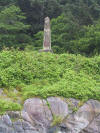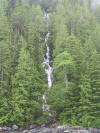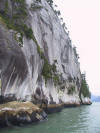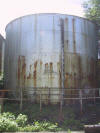|
 |
Day 13:
Cathedral Point Cove, Burke Channel |
|
 |
We left a misty Ocean Falls early the next morning to tour around King
Island through Dean Channel. It is here that Alexander Mackenzie finally
reached the Pacific coast traveling overland from Canada, which at the time
included only portions of the present day provinces of Ontario and Quebec.
Mackenzie marked his arrival at salt water with an inscription on a rocky
face, the surrounding bluff now the site of the small Sir Alexander
Mackenzie Provincial Park, which includes an obelisk, pictured, in honour of
the great explorer. Having learned of this site in Canadian history class so
many years ago, it was very exciting to actually see it. |
|
 |
This is a close-up of the inscription. It was originally written in
vermillion paint mixed with grease and later carved permanently into the
rock by surveyors. Mackenzie was the first to cross the continent and to
find a trail through the Rocky Mountains. Low on food and energy, his
expedition missed that of Captain Vancouver's by only 7 weeks. The
Chatham and Discovery would certainly have been a welcome
sight for the weary travelers. |
|
 |
The scenery is in Dean
Channel is grand - soaring mountains with big snow banks and waterfalls
everywhere. The landscape is immense, massive, overwhelming – majestic
snow-capped peaks, one after another, and everywhere waterfalls dropping
from great heights into the deep sea below. Even the mist and
rain did not detract from the majesty of the scenery. The low clouds ring the mountains and catch on the
trees, but they are not solid, and merely emphasize the impenetrability of
the rocky cliffs. |
|
 |
We saw the Discovery Coast ferry in the distance - its a great looking boat.
It had headed down Cascade Inlet on sort of a whim I guess, as it is not
on the route at all. Traveling on it sounds very similar to the old Union
Steamships. Many of the stories in Andrew Scott's Secret Coastline
were researched on this route, including the inaugural run. |
|
 |
Our next stop was the hot springs at
Eucott Bay,
opposite the northeast corner of King Island. We anchored in the bay and
brought the dinghy to shore. Gumboots are definitely recommended for this
trip. This is a view of the springs from the water. |
|
 |
Over the years
people have built a wonderful tub enclosure complete with a ladder and
benches. The water coming in (through the pipe at bottom left) was 103
degrees. We soaked and soaked - it was very decadent and completely
deserted. |
|
 |
Where
Labouchere and Burke Channel meet there is is an interesting glacial
formation called
Mesachie Nose
that plunges straight down into the water from a great height - similar to
Deep Sea Bluff in the Broughton Archipelago area. The water here is frequently whipped into steep chop by the
wind, but if conditions are calm, you can bring the boat up very close to
the face. It is sadly covered with graffiti, although some are so old,
dating back to the 1960s, that they may be considered petroglyphs now :) |
|
 |
This is a view of the dramatic Nose from a
distance. |
|
 |
We were hoping to make it all the
way out of Burke Channel today, but it was getting too late, so we stopped
of at the cove behind Cathedral Point instead. This is where one of the
marine weather stations is installed - the small structure on the hill by
the helicopter pad. Judging by the bent over trees the area sure takes a
pounding in storms. It was always fun to hear the weather report from this
station after having stayed here. We had a little trouble setting the
anchor, but once we got a good bite we held well and slept soundly, despite
the winds from Burke which wrapped around the corners into the cove. |
|
 |
Day 14:
Fly Basin, Smith Sound |
|
 |
The day was sunny and calm as we cover the final bit of Burke Channel,
leaving the Coast Mountains behind. We have been utterly spoiled with the
weather on this trip. |
|
 |
A group of Dall's Porpoises chased along with us for a bit. They are always
welcome travel companions. |
|
 |
We passed a mammoth log with lots of seagulls who, judging by the white
streaks on the wood, and been there a while. It looked a bit like a Seagull
bus. |
|
 |
We hit a bit of a fogbank, the soon passed through it, which you can see at
the left of the picture. The world was aglow as the sun rose higher in the
sky and chased away the mist. As we approached Fitz Hugh Sound lots of
traffic was visible - we are used to seeing maybe one or two boats a day and
now we can see five at once. |
|
 |
Proceeding south, we stopped to visit another once-thriving town – Namu. If
you have read Fishing with John, this is where John Daly preferred to
get his ice. The town was once a major fish processing center, with
a cannery and a herring reduction plant, but is mostly vacant now, with only
a caretaker and his family living on site. The name is well known for the
killer whale Namu, which was captured here in 1965 and sold to the Seattle
Aquarium. |
|
 |
This is what's left of the herring reduction plant - it's slowly collapsing. |
|
 |
The cannery workers lived in these houses. |
|
 |
This is a old wooden pipe wrapped in metal used to transport water from
nearby Namu Lake to the cannery, which consumed a huge amount of fresh water. |
|
 |
There is a 1-mile raised trail through the woods to Namu Lake, both of which
are quite pretty. The trail is in reasonable repair, but a little iffy
at points. Apparently there are bears about, but we didn't see any. |
|
 |
The old hotel, once a bustle of activity, although probably never a part of
the Hilton hotel chain :) |
|
 |
Inside the generator room for the herring reduction plant, we found a row of
seven huge diesel engines. They were in good repair and were clearly being
looked after, so they likely still run. Must be worth a fortune. An
interesting mix of companies:
4 Detroit
Diesel, with Electric Motor company generators, 1 Air Diesel by Deutz of
Germany, 1 big Cat, 1 Isizu with Stamford generator. |
|
 |
A huge 85,000-gallon vat for herring oil, which was reduced at a rate of 100
tons/day. |
|
 |
A caretaker and his family are the only residents of Namu. This is his
daughter Katrina and her dog
Kamodie. It is
a fairly isolated existence – schooling is done through correspondence –
but Katrina has many pen pals in similar situations whose letters to each
other are delivered by the mission ship Coastal Messenger. Katrina is
surprisingly outgoing and, being very knowledgeable about the history of
Namu, gives wonderful tours of the area. |
|
 |
Leaving Namu, we continued south into Fitz Hugh Sound in search of an
anchorage. The day was warm and sunny with a stunningly blue sky. En route,
the Alaska state ferry Columbia passed us heading north from
Bellingham. Looking
more like a cruise ship than a ferry, the 418-foot vessel plies the same
waters, carrying both cars and passengers, enabling a much more economic,
although certainly less pampered, means of touring the Inside Passage. The
Columbia
carries up to 625 passengers, who can optionally book one of the 104 cabins,
which are charged for by room, not by person. However, many simply roll out
a sleeping bag in the solarium or stretch out in one of the reclining lounge
chairs for the night. The largest of the nine vessels in the Alaska Marine
Highway System, it is also the fastest, with a cruising speed of just over
17 knots. |
|
 |
We eventually anchored in Fly Basin in Smith Inlet, after an exciting, but
very long and tiring day - we put 10 hours on the engines. This is the view
looking east as we entered the Smith. The 25-30 knot afternoon winds had
stirred up some big waves which we took mostly on the beam as we crossed,
but other than getting bounced around a bit, we were fine. |
|
 |
This is the view looking east from our anchorage in the northeast corner of
Fly Basin – we were happy to finally stop. Got an excellent hold in mud in
40' with plenty of swing room and 175'
of rode out. We saw frequent 25 knots gusts from west,
but held solidly. We were too tired to
eat much - I baked bread and after that was done baked some sweet onions and that
was pretty much dinner. We fell into bed early to be off to cross Queen Charlotte
Sound the next day. |